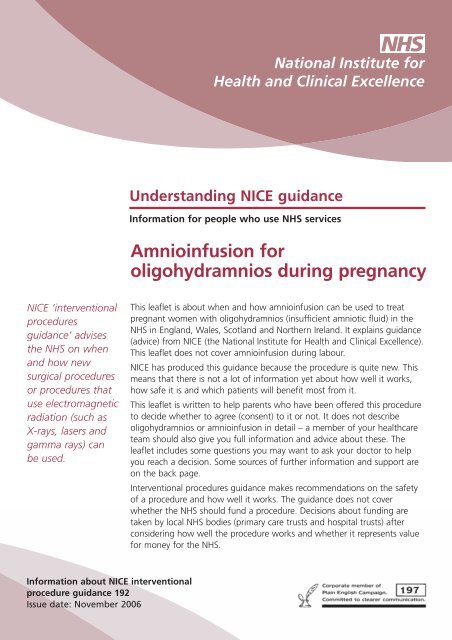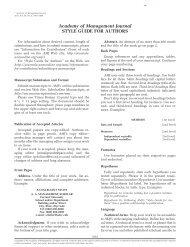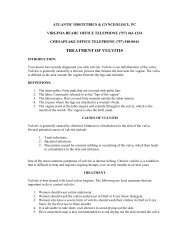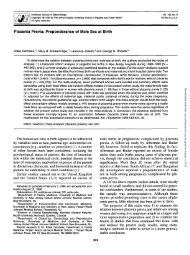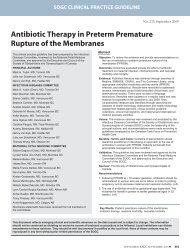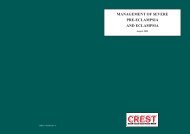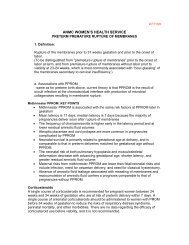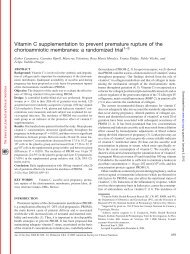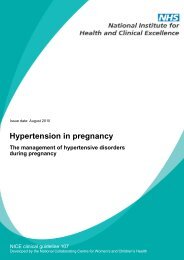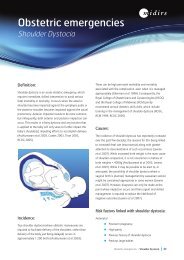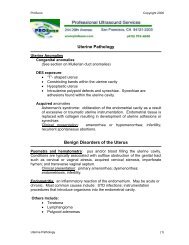IPG192 Amnioinfusion for oligohydramnios during pregnancy ...
IPG192 Amnioinfusion for oligohydramnios during pregnancy ...
IPG192 Amnioinfusion for oligohydramnios during pregnancy ...
Create successful ePaper yourself
Turn your PDF publications into a flip-book with our unique Google optimized e-Paper software.
Understanding NICE guidanceIn<strong>for</strong>mation <strong>for</strong> people who use NHS services<strong>Amnioinfusion</strong> <strong>for</strong><strong>oligohydramnios</strong> <strong>during</strong> <strong>pregnancy</strong>NICE ‘interventionalproceduresguidance’ advisesthe NHS on whenand how newsurgical proceduresor procedures thatuse electromagneticradiation (such asX-rays, lasers andgamma rays) canbe used.This leaflet is about when and how amnioinfusion can be used to treatpregnant women with <strong>oligohydramnios</strong> (insufficient amniotic fluid) in theNHS in England, Wales, Scotland and Northern Ireland. It explains guidance(advice) from NICE (the National Institute <strong>for</strong> Health and Clinical Excellence).This leaflet does not cover amnioinfusion <strong>during</strong> labour.NICE has produced this guidance because the procedure is quite new. Thismeans that there is not a lot of in<strong>for</strong>mation yet about how well it works,how safe it is and which patients will benefit most from it.This leaflet is written to help parents who have been offered this procedureto decide whether to agree (consent) to it or not. It does not describe<strong>oligohydramnios</strong> or amnioinfusion in detail – a member of your healthcareteam should also give you full in<strong>for</strong>mation and advice about these. Theleaflet includes some questions you may want to ask your doctor to helpyou reach a decision. Some sources of further in<strong>for</strong>mation and support areon the back page.Interventional procedures guidance makes recommendations on the safetyof a procedure and how well it works. The guidance does not coverwhether the NHS should fund a procedure. Decisions about funding aretaken by local NHS bodies (primary care trusts and hospital trusts) afterconsidering how well the procedure works and whether it represents value<strong>for</strong> money <strong>for</strong> the NHS.In<strong>for</strong>mation about NICE interventionalprocedure guidance 192Issue date: November 2006
What has NICE said?There are still uncertainties over the safety of this procedure andhow well it works. If a doctor wants to use amnioinfusion he or sheshould make sure that extra steps are taken to explain theuncertainty and the likely benefits and potential risks of theprocedure. This should happen be<strong>for</strong>e the parents agree (or don’tagree) to the procedure. The parents should be given this leaflet andother written in<strong>for</strong>mation as part of the discussion. There shouldalso be special arrangements <strong>for</strong> monitoring what happens afterthe procedure.This procedure should only be carried out in a specialist centre, by ateam that may include a consultant in fetal medicine, aneonatologist and a specialist midwife.Further in<strong>for</strong>mation on the safety of amnioinfusion and how well itworks will be helpful. NICE has encouraged doctors to ask patientsto take part in clinical trials looking at amnioinfusion <strong>for</strong><strong>oligohydramnios</strong>. NICE may look at this procedure again if morein<strong>for</strong>mation becomes available.This procedure maynot be the onlypossible treatment<strong>for</strong> <strong>oligohydramnios</strong>.Your healthcareteam should talk toyou about whetherit is suitable <strong>for</strong> youand about anyother treatmentoptions available.<strong>Amnioinfusion</strong>The procedure is not described in detail here – please talk to yourobstetrician <strong>for</strong> a full description.Oligohydramnios is the medical term <strong>for</strong> having too little amniotic fluidaround the baby in the womb. It has many different possible causes.Severe <strong>oligohydramnios</strong> early in a <strong>pregnancy</strong> may affect the way the unbornbaby grows.Oligohydramnios is not generally treated. Usually, the doctor checks thegrowing baby regularly and allows nature to take its course. In amnioinfusion,a solution that is similar to amniotic fluid is injected through the mother’sabdomen (belly) and into the space around the baby. The doctor usesultrasound to watch what he or she is doing. The procedure can be doneseveral times (which is called serial amnioinfusion).prgmea.comIn<strong>for</strong>mation 2 about about NICE NICE interventional procedure guidance guidance 192 xxx
Three studies showed that amnioinfusion increased the chances of babiesliving after birth. In women who were treated, two out of 11 (18%), 6 outof 26 (23%) and 3 out of 11 (27%) babies died. In women who were nottreated 5 out of 7 (71%), 5 out of 13 (38%) and 23 out of 29 (79%)babies died. One other study showed no difference in the survival of babiesborn to women who were treated and women who were not treated.Risks and possible problemsIn a study of 45 women treated with amnioinfusion, 1 went into laboursoon after the procedure. Miscarriage occurred in 11–21% of women inanother study and was more likely if the membranes had ruptured.<strong>Amnioinfusion</strong> seemed to reduce the number of babies who died in thewomb. In four studies, up to 14% of babies whose mothers were treateddied, compared with up to 38% of babies whose mothers were not treated.Other problems were placental abruption (where the placenta comes awayfrom the womb), which occurred in up to 25% of pregnancies, andinfection of the membranes and fluid (chorioamnionitis) in up to 32%. Onebaby was born with a cut to the leg, which required stitches.More in<strong>for</strong>mation about <strong>oligohydramnios</strong>in <strong>pregnancy</strong>NHS Direct online (www.nhsdirect.nhs.uk) may also be a good starting point<strong>for</strong> finding out more. Your local Patient Advice and Liaison Service (PALS) mayalso be able to give you further advice and support.About NICENICE produces guidance (advice) <strong>for</strong> the NHS about preventing, diagnosing and treatingdifferent medical conditions. The guidance is written by independent experts includinghealthcare professionals and people representing patients and carers. They consider how wellan interventional procedure works and how safe it is, and ask the opinions of expert advisers.Staff working in the NHS are expected to follow this guidance.To find out more about NICE, its work and how it reaches decisions, seewww.nice.org.uk/aboutguidanceThis leaflet and the full guidance aimed at healthcare professionals are available atwww.nice.org.uk/<strong>IPG192</strong>You can order printed copies of this leaflet from the NHS Response Line(phone 0870 1555 455 and quote reference N1135).prgmea.comNational Institute <strong>for</strong> Health and Clinical ExcellenceMidCity Place, 71 High Holborn, London WC1V 6NA; www.nice.org.uk ISBN 1-84629-301-4N1135 1P Nov 06© National Institute <strong>for</strong> Health and Clinical Excellence, November 2006. All rights reserved. This material maybe freely reproduced <strong>for</strong> educational and not-<strong>for</strong>-profit purposes. No reproduction by or <strong>for</strong> commercialorganisations, or <strong>for</strong> commercial purposes, is allowed without the express written permission of the Institute.


